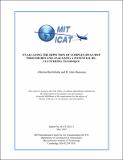| dc.contributor.author | Butchibabu, Abhizna | |
| dc.contributor.author | Hansman, R. John | |
| dc.date.accessioned | 2012-05-10T21:05:06Z | |
| dc.date.available | 2012-05-10T21:05:06Z | |
| dc.date.issued | 2012-05-10 | |
| dc.identifier.uri | http://hdl.handle.net/1721.1/70570 | |
| dc.description.abstract | Performance Based Navigation (PBN) is a key element of the Federal Aviation Administration’s
(FAA) NextGen Program. In order to increase National Airspace System (NAS) capacity and
efficiency, PBN routes and procedures are being developed, including Area Navigation (RNAV)
and Required Navigation Performance (RNP) procedures. RNAV enables aircraft to fly directly
from point-to-point on any desired flight path using ground- or spaced-based navigation aids.
RNP is RNAV with the addition of onboard monitoring and alerting capability. Both RNAV and
RNP procedures allow aircraft to fly accurate routes without relying on ground-based navigation
aids. RNAV and RNP procedures facilitate more efficient design of airspace and procedures,
offering significant safety improvements and flexibility to negotiate terrain, as well as improving
airspace capacity and operational efficiency.
The initial implementation of RNAV and RNAV (RNP) procedures has raised several human
factors issues. RNAV (RNP) Instrument Approach Procedures (IAP) and RNAV Standard
Instrument Departures (SID) and Standard Terminal Arrivals (STARs) often have more
waypoints, altitude constraints and other elements than conventional procedures, resulting in
charts being cartographically complex. Thus, a chart review was conducted to objectively
understand the procedure elements that contributed to increased information density and high
levels of visual clutter.
A total of sixty-three approach, fifty-two departure, and fifty-four arrival procedures were
analyzed. Primary findings were that the factors associated with high levels of visual clutter
included having multiple flight paths per page for approach and departure procedures, and having
complex altitude constraints for arrival procedures. Multiple waypoints per path was also a factor
for both arrivals and approaches. In addition, having RF legs were additional factor contributing
to visual clutter for approach procedures.
One method to mitigate the increased information density and visual clutter on the RNAV and
RNP procedure depiction is to reduce the number of flight paths shown on a single page by
separating the depicted paths to multiple pages. However, there are a number of drawbacks to
4
this clutter mitigation technique. Example drawbacks include having more paper to carry in the
flight deck and more time spent searching for the correct page within a set of separated pages.
An experiment was conducted to determine the effect of reducing the number of paths depicted
on single-page “Modified” charts. FAA AeroNav Products and Jeppesen created versions of the
Modified chart in their standard cartographical conventions. The experiment was conducted to
evaluate whether these Modified charts would impact information retrieval time and accuracy
compared with the “Current” charts being used now. Current FAA AeroNav Products and
Jeppesen charts were used as the baseline condition. Six procedures were studied, including three
RNAV departure procedures from Dallas/Fort Worth, Las Vegas, and Salt Lake City airports, and
three RNAV (RNP) approach procedures from Boise, Bozeman, and Palm Springs airports.
During the experiment, pilots were shown the same procedure in Current and Modified chart
formats. | en_US |
| dc.description.sponsorship | This project was funded by the Federal Aviation Administration (FAA) Human Factors
Research and Engineering Division (ANG-C1) and US DOT Volpe Center with support from
the FAA’s Aviation Safety (AVS) and Flight Standards (AFS-470) divisions under the grant
No. DTR57-07-D-30006. Abhizna Butchibabu was supported by an Avidyne Fellowship funded by Dan Schwinn
for much of this work. | en_US |
| dc.relation.ispartofseries | ;ICAT-2012-3 | |
| dc.rights | An error occurred on the license name. | en |
| dc.rights.uri | An error occurred getting the license - uri. | en |
| dc.subject | Performance Based Navigation | en_US |
| dc.subject | NextGen Program | en_US |
| dc.subject | Area Navigation | en_US |
| dc.subject | Required Navigation Performance | en_US |
| dc.subject | Air Transportation | en_US |
| dc.title | Evaluating The Depiction of Complex RNAV/RNP Procedures and Analyzing a Potential De-Cluttering Technique | en_US |
| dc.type | Technical Report | en_US |
